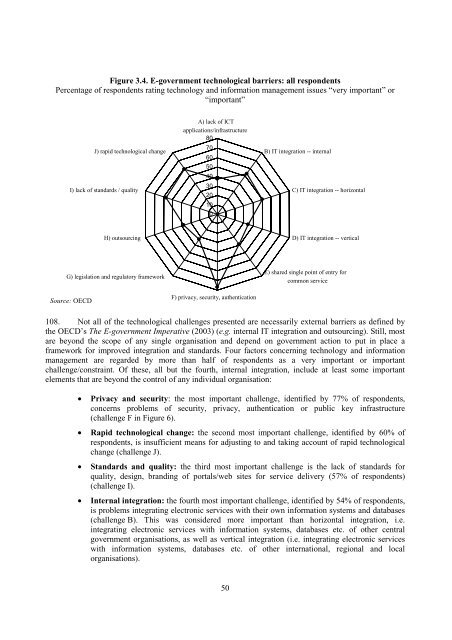e-GOVERNMENT IN FINLAND - ePractice.eu
e-GOVERNMENT IN FINLAND - ePractice.eu
e-GOVERNMENT IN FINLAND - ePractice.eu
Create successful ePaper yourself
Turn your PDF publications into a flip-book with our unique Google optimized e-Paper software.
Figure 3.4. E-government technological barriers: all respondents<br />
Percentage of respondents rating technology and information management issues “very important” or<br />
“important”<br />
I) lack of standards / quality<br />
G) legislation and regulatory framework<br />
Source: OECD<br />
J) rapid technological change<br />
H) outsourcing<br />
A) lack of ICT<br />
applications/infrastructure<br />
80<br />
70<br />
60<br />
50<br />
40<br />
30<br />
20<br />
10<br />
0<br />
F) privacy, security, authentication<br />
108. Not all of the technological challenges presented are necessarily external barriers as defined by<br />
the OECD’s The E-government Imperative (2003) (e.g. internal IT integration and outsourcing). Still, most<br />
are beyond the scope of any single organisation and depend on government action to put in place a<br />
framework for improved integration and standards. Four factors concerning technology and information<br />
management are regarded by more than half of respondents as a very important or important<br />
challenge/constraint. Of these, all but the fourth, internal integration, include at least some important<br />
elements that are beyond the control of any individual organisation:<br />
x Privacy and security: the most important challenge, identified by 77% of respondents,<br />
concerns problems of security, privacy, authentication or public key infrastructure<br />
(challenge F in Figure 6).<br />
x Rapid technological change: the second most important challenge, identified by 60% of<br />
respondents, is insufficient means for adjusting to and taking account of rapid technological<br />
change (challenge J).<br />
x Standards and quality: the third most important challenge is the lack of standards for<br />
quality, design, branding of portals/web sites for service delivery (57% of respondents)<br />
(challenge I).<br />
x Internal integration: the fourth most important challenge, identified by 54% of respondents,<br />
is problems integrating electronic services with their own information systems and databases<br />
(challenge B). This was considered more important than horizontal integration, i.e.<br />
integrating electronic services with information systems, databases etc. of other central<br />
government organisations, as well as vertical integration (i.e. integrating electronic services<br />
with information systems, databases etc. of other international, regional and local<br />
organisations).<br />
50<br />
B) IT integration -- internal<br />
C) IT integration -- horizontal<br />
D) IT integration -- vertical<br />
E) shared single point of entry for<br />
common service
















